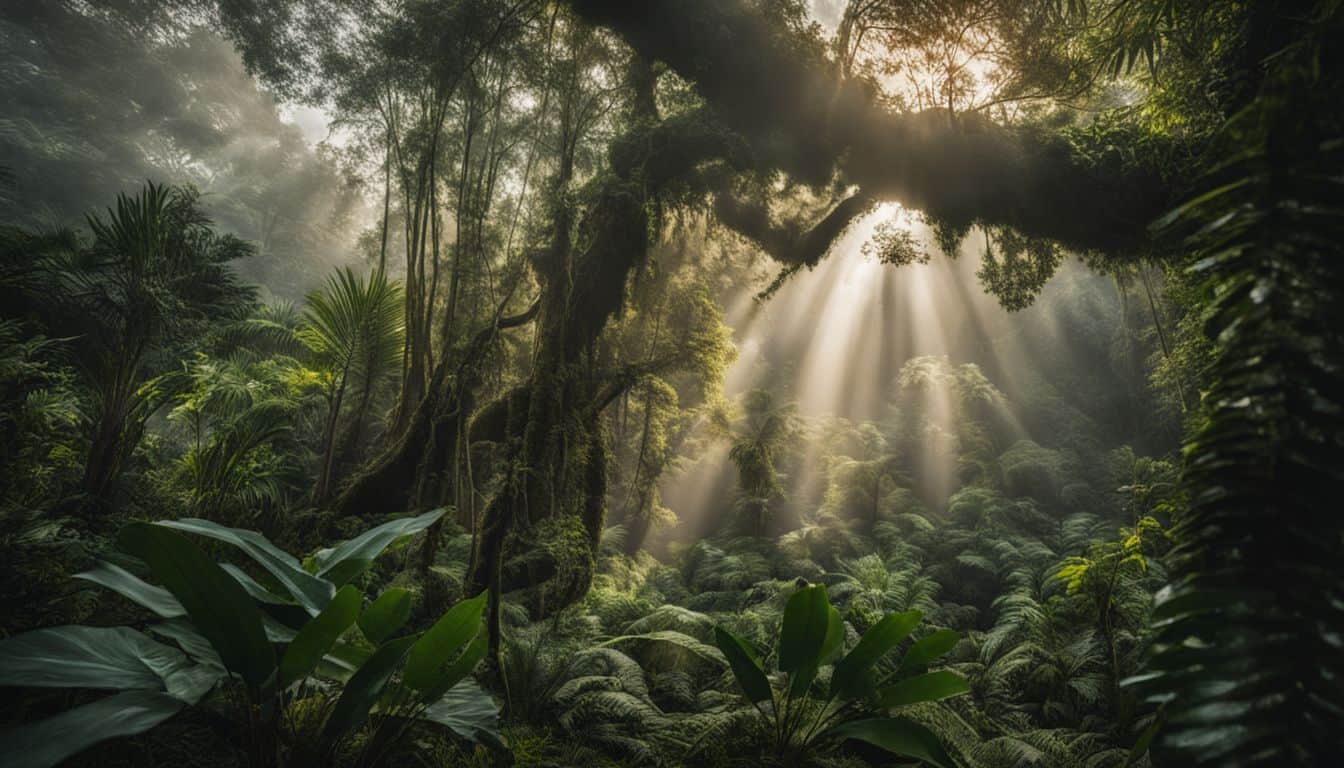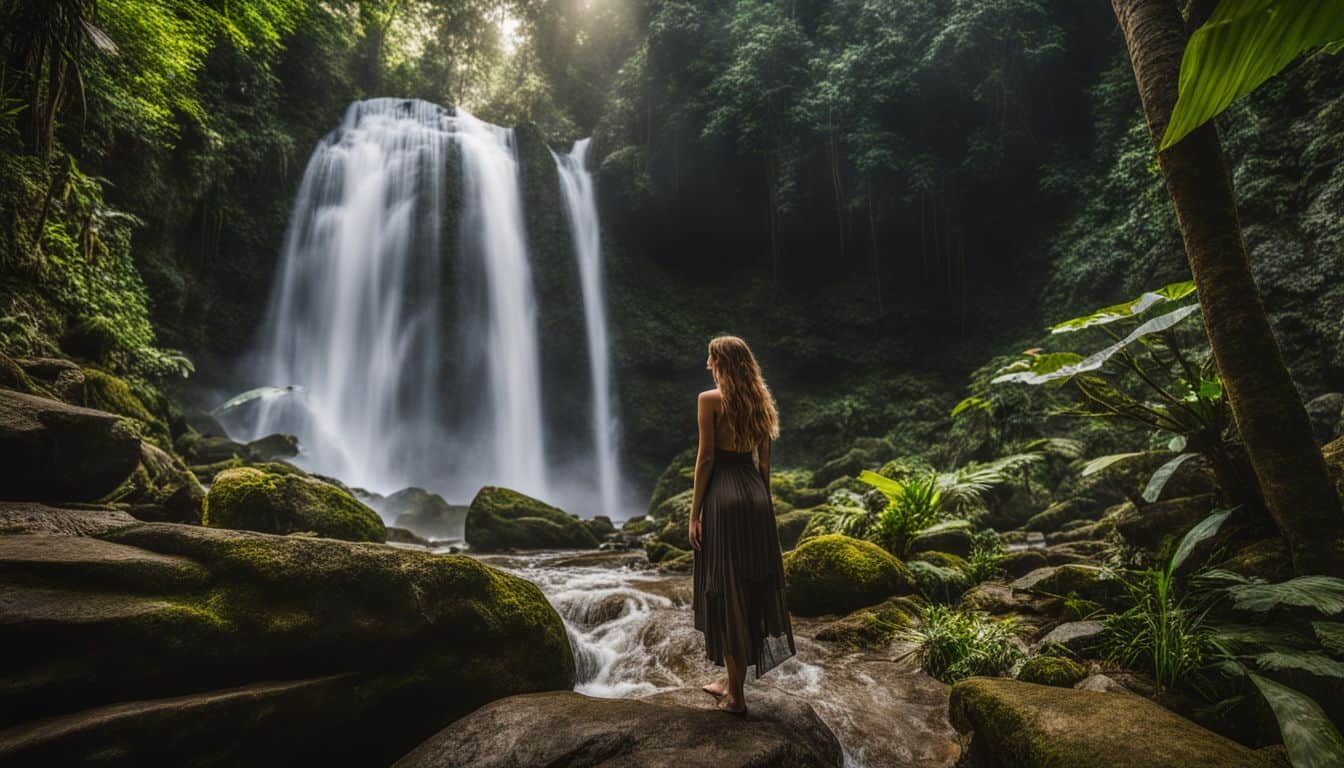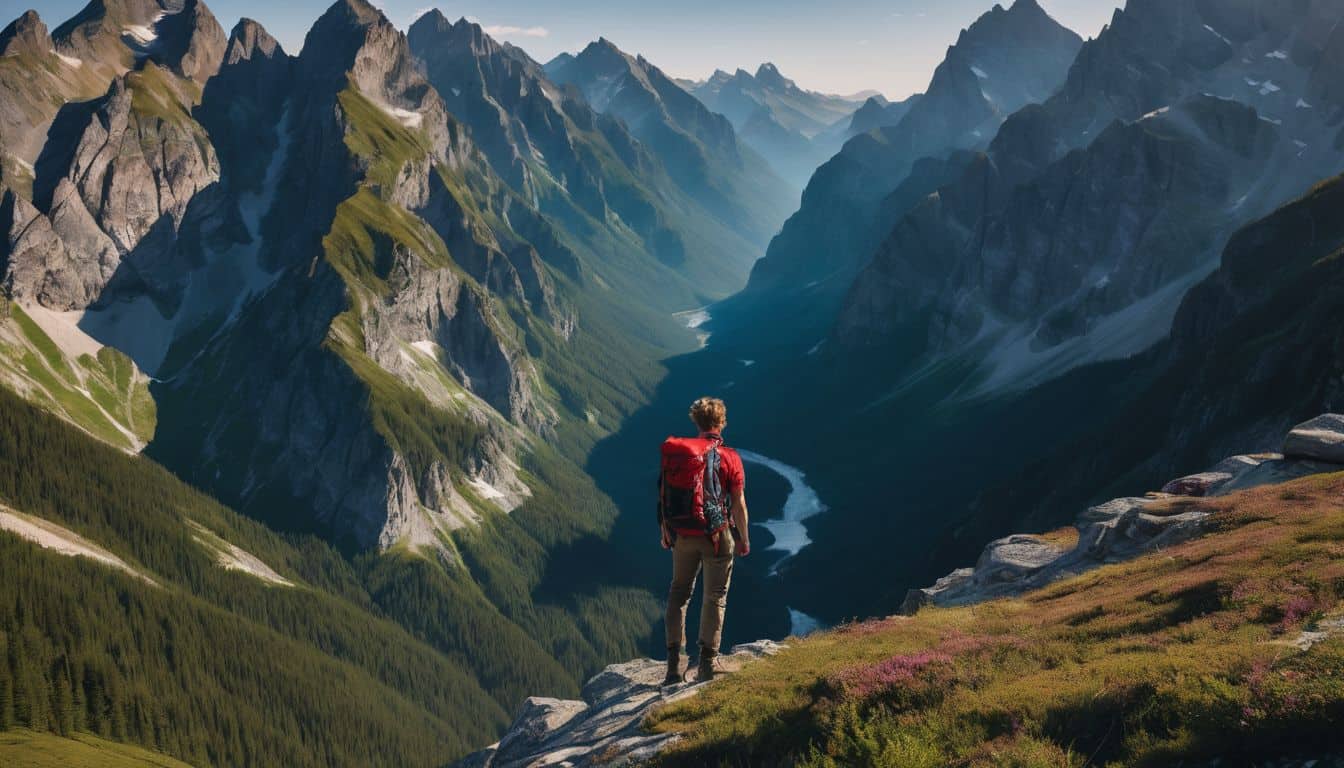Surviving a tropical climate survival isn’t just a matter of grit, it’s practically an art form – one I’ve learned through sweat, sunburns and more than my fair share of mosquito bites. Covering over 12 percent of the Earth’s land surface, we’ve got tropical forests teeming with diverse life forms that can both enthrall and intimidate us at the same time.
So whether you’re drawn to these locales for the sheer thrill or if life has planted your feet firmly in lush soils, understanding how to navigate this unique environment is vital.
In this blog post, I’m giving you seven tried-and-tested strategies for not just surviving but really flourishing under that tropical sun. You ready? Okay! Let’s dive into beating extreme heat and thriving like a true trooper in the tropics!
Key Takeaways
- Stay hydrated by drinking plenty of clean and safe water to avoid dehydration in tropical climates.
- Wear natural fabrics like cotton or linen to allow your skin to breathe and regulate your body temperature in hot and humid conditions.
- Seek shelter and shade to protect yourself from the sun’s rays, use head covers like hats or scarves, and create shade structures using natural materials.
- Be prepared to make fire for cooking and signaling purposes, and follow fire safety precautions at all times.
Understanding the Impact of Tropical Climate
Tropical climates have extreme heat and high humidity, which can increase the risk of dehydration.
Extreme heat
In a tropical climate, extreme heat is a big worry. The hotter it gets, the harder it is to cool down. Low birth weight and other health issues can happen if you are out in the heat for too long.
Heat also makes work outside tough. Dry times can get worse with more heat and start wildfires too. For safety, avoid the sun at its hottest time of day, stay in shade when you can, and always have water nearby to drink.
High humidity
High humidity can make a hot day feel hotter. This is because your body cannot cool down the way it usually does. Your sweat doesn’t dry up as fast when there’s too much water in the air.
It’s harder to breathe and you feel worn out faster. Your heart has to work hard, which can be bad for people with heart problems.
Humidity mixed with high heat makes you tired faster. It also raises your body’s core temperature and increases strain on your heart. Hot desert climates have extreme temperatures while humid subtropical ones show us how heat and moisture combined pose risks too.
We must be alert about these facts so we stay safe in a tropical climate.
Increased risk of dehydration

In tropical places, you sweat a lot. This is due to the high heat and humidity. But sweating can cause your body to lose water fast. This can lead to dehydration, which is bad for your health.
Climate change also plays a role in how much water we have. It brings on heavy rains sometimes but it also causes long dry spells where there is no rain at all. Without enough drinking water around, people are more likely to get dehydrated.
Kids and older folks should be more careful because they get dehydrated faster than others do.
Dehydration isn’t just about feeling thirsty or tired, either. Did you know that losing too much water from our bodies can make us think less clearly? Indeed, if we don’t drink enough fluids when it’s hot out, our brains might not work as well as they normally would!
So whether you’re camping in the jungle or just spending time outside on a sunny day – remember this: always drink lots of clean and safe water!
Stay Cool and Hydrated
To stay cool and hydrated in a tropical climate, drink plenty of water throughout the day to replenish fluids lost through sweat. Wear natural fabrics like cotton or linen that allow your skin to breathe and regulate your body temperature.
Adjust your exercise routine to avoid the hottest times of the day and take regular showers to cool off.
Drink plenty of water
Staying hydrated is crucial when facing the challenges of a tropical climate. Drinking plenty of water not only helps prevent discomfort and stiffness in your joints, but it also supports your digestive and respiratory health by promoting saliva and mucus production.
Adequate hydration is essential for maintaining healthy skin, preventing dryness and wrinkles. Additionally, staying well-hydrated can activate your metabolism, giving you that much-needed boost of energy.
On the other hand, dehydration can lead to unclear thinking, mood changes, and even overheating of the body. So remember to drink enough water throughout the day to keep yourself cool and properly hydrated in a tropical environment.
Use natural fabrics
When it’s hot and humid in a tropical climate, it’s important to wear the right clothes to stay cool and hydrated. That’s why I recommend using natural fabrics like silk, linen, cotton, and ramie.
These fabrics are breathable and allow air to circulate around your body, helping to regulate your temperature. They also have moisture-wicking properties that draw sweat away from your skin, keeping you dry and comfortable.
Synthetic fabrics can trap heat and moisture, which can make you feel uncomfortable and lead to dehydration. So remember to choose clothes made from a combination of these natural fibers for optimal comfort in tropical climates.
Regulate exercise and workout routine
Staying active in a tropical climate can be challenging, but with some adjustments to your workout routine, you can still stay fit and healthy. Here are some tips for regulating exercise in hot and humid weather:
- Drink plenty of water before, during, and after your workout to stay hydrated.
- Take breaks and rest in the shade to avoid overheating.
- Wear lightweight and breathable clothing to help keep your body cool.
- Time your workouts for early mornings or evenings when it’s cooler outside.
- Listen to your body and don’t push yourself too hard. It’s important to avoid overexertion in extreme heat.
- Consider indoor activities like swimming or yoga if the weather is too intense outside.
Take regular showers
Regular showers are essential for staying cool and hydrated in a tropical climate. When the weather is hot and humid, taking cool showers or baths can provide instant relief from the heat.
It’s also important to move to air-conditioned places whenever possible to bring down your body temperature. Additionally, using damp towels with ice, putting your feet in cold water, and taking cool showers throughout the day can help you stay cool in hot weather.
Remember to wear light-colored, loose-fitting clothing and take regular breaks indoors or in shady areas to prevent heat exhaustion or heatstroke. By immersing yourself in a cool body of water or using shower facilities before bed on summer camping trips, you can effectively lower your body temperature for a more comfortable sleep.
Seek Shelter and Shade
Choose appropriate camp locations to avoid excessive exposure to the sun’s rays. Use head covers such as hats or scarves to protect your face and neck from direct sunlight. Create shade structures using natural materials like branches or tarps to provide relief from the intense heat.
Choose appropriate camp locations
Choosing the right camp location is super important when you’re in a tropical climate. One thing to consider is finding shelter and shade. Look for areas with low lying foliage or natural shelters like caves or overhanging rocks.
This will protect you from the sun’s heat and keep you cooler. It’s also a good idea to find flat ground for your cooking area and sleeping spot. Avoid setting up camp near tall trees, mountaintops, and high ridges because they can attract lightning during storms.
So remember, when camping in a tropical climate, choose a spot with plenty of shade and protection from the elements!
Use head covers
Head covers are an important tool for surviving in tropical climates. They provide much-needed shade and protection from the intense heat of the sun. By wearing a hat or using a scarf to cover your head, you can prevent overheating and reduce the risk of sunburn.
Head covers also help to keep you cool by shielding your face and neck from direct sunlight. Additionally, they can protect you from insects and other potential hazards in the environment.
So, whether it’s a wide-brimmed hat or a lightweight scarf, don’t forget to use head covers when venturing out into the tropical heat.

Create shade structures
Creating shade structures is essential for surviving in tropical climates. It helps protect us from the harsh sun and provides a cooler environment. Here are some ways to create shade:
- Use sunshades or canopies: These portable structures can be set up quickly and provide instant shade wherever you need it.
- Apply sunscreen: Don’t forget to protect your skin from harmful UV rays by regularly applying sunscreen with a high SPF.
- Seek out sheltered areas: Look for natural or man-made structures, such as trees, buildings, or awnings, that provide shade during the hottest parts of the day.
- Carry an umbrella: A compact umbrella can be a lifesaver when you need quick relief from the sun.
- Make use of shade sails: These sail-like structures can be installed over outdoor spaces to create a shaded area.
- Construct an awning: If you’re staying in one place for a while, consider building an awning using tarpaulin or other durable materials.
- Utilize sun blockers: Attach fabric or sheets on stakes to block the sun’s direct rays and create shaded spots.
Fire Safety in Tropical Climate
Be prepared to start a fire for cooking and signaling, and make sure to follow fire safety precautions at all times.
Be prepared to make fire
To survive in a tropical climate, it’s important to know how to make fire. Fire can help you cook food and signal for help if needed. Make sure you have the necessary tools, like matches or a lighter, in your survival kit.
You should also gather dry sticks and other flammable materials ahead of time so that you’re prepared when you need to start a fire. Remember to follow fire safety precautions and never leave a fire unattended.
Being able to make fire is an essential skill for surviving in the tropics.
Use fire for cooking and signaling
Fire is a powerful tool that can help me meet many survival needs in a tropical climate. Here are some ways I can use fire to my advantage:
- Cook food: Fire can be used to cook the food I find or catch in the wild. It helps to kill any harmful bacteria and makes it safe to eat. I just need to make sure I have enough fuel, like wood or dried leaves, to keep the fire going.
- Boil water: In a tropical climate, finding clean and safe drinking water can be a challenge. By using fire, I can boil water to kill any germs or parasites that may be present. This will ensure that I stay hydrated and avoid getting sick from contaminated water sources.
- Create smoke signals: If I ever find myself lost or in need of rescue, fire can be used to create smoke signals. By adding green vegetation or wet leaves to the fire, thick smoke will be produced, which can help rescuers spot my location from afar.
- Provide warmth: Even in a tropical climate, nights can get surprisingly cold. Having a fire nearby can provide much-needed warmth and comfort during chilly evenings.
- Keep away pests: Mosquitoes and other insects are common in tropical areas and can carry diseases. The smoke from the fire acts as a natural repellent and keeps these pests away, reducing the risk of mosquito-borne illnesses.
- Boost morale: Being alone in a survival situation can be mentally challenging. The presence of a fire provides light and warmth, creating a sense of security and boosting morale.
Follow fire safety precautions
When it comes to surviving in a tropical climate, it’s important to follow fire safety precautions. Here are some tips to help you stay safe:
- Keep a fire extinguisher nearby and make sure it’s in good working condition.
- Avoid open fires during hot, dry, and windy conditions.
- Clear any flammable materials from around your campsite or shelter.
- Never leave a fire unattended and always fully extinguish it before leaving.
- Learn how to properly use a fire extinguisher, including the PASS technique (Pull, Aim, Squeeze, Sweep).
- Be aware of any local fire restrictions or bans and follow them accordingly.
- If you’re cooking with an open flame, make sure you have proper ventilation to prevent carbon monoxide buildup.
Understanding the Basics of Tropical Climate Survival
Tropical climate survival can be challenging, but with some basic knowledge, you can be better prepared. The tropics are regions that lie near the middle of the globe and experience high temperatures and humidity.
Rainfall is an important factor in tropical climates, as monsoon seasons bring much-needed water. Tropical forests cover a significant portion of Earth’s land surface and play a crucial role in maintaining our climate.
When it comes to surviving in tropical climates, understanding adaptation is key. The local ecosystem has evolved to thrive in these conditions, so learning from it can help us survive too.
This includes knowing how to find food and water sources, identifying useful plants for medicinal purposes or building materials, and avoiding contact with poisonous plants or dangerous animals.
Humidity in tropical areas can lead to increased risk of dehydration. To combat this, staying cool and hydrated is vital. Drink plenty of water throughout the day and avoid excessive physical exertion during the hottest times.
Wearing natural fabrics like cotton allows your skin to breathe more easily.
Seeking shelter from extreme heat is also important for survival. Choose appropriate camp locations that offer shade during the hottest parts of the day. Using head covers like hats or scarves can provide added protection against direct sunlight.
By understanding these basics of tropical climate survival, you will be better equipped to handle the challenges that come with living or traveling in these regions.
Learn from the Bedouins
Learn from the Bedouins to adapt to the local survival techniques, avoid traveling during the hottest time of the day, and follow their ancient technique of staying cool in a tropical climate.
Avoid traveling during the hottest time of the day
In tropical climates, it’s important to avoid traveling during the hottest time of the day. I learned from the Bedouins that they traditionally travel at night and rest during the day to stay cool.
The temperature drops significantly after sunset, making nights much cooler than days. By seeking shelter and avoiding direct exposure to the sun, you can prevent heat-related problems like dehydration and heatstroke.
So if you want to survive in a tropical climate, make sure to plan your activities accordingly and take advantage of the cooler hours.
Follow the ancient technique of staying cool
The ancient Bedouins had some amazing techniques to stay cool in tropical climates, and we can learn a lot from them. One of their methods was wearing loose clothing that allowed air to circulate and helped reduce heat absorption.
This is something we can easily adopt to stay cool in hot weather. By choosing natural fabrics like cotton or linen that allow air flow, we can keep ourselves comfortable even when the temperature rises.
So next time you’re heading out into the heat, remember to dress in loose, breathable clothing inspired by the ancient wisdom of the Bedouins. Stay cool!
Adapt to the local survival techniques
When surviving in a tropical climate, it’s important to adapt to the local survival techniques. Here are some ways you can do that:
- Learn from the Bedouins: The Bedouins are Arab-speaking nomadic peoples who have mastered survival in desert environments. Their techniques can be beneficial in extreme situations where finding water becomes a challenge.
- Celestial navigation: Bedouins relied on celestial navigation to navigate through the desert. They used the stars and the moon as their guides. Learning basic celestial navigation skills can help you find your way in unfamiliar terrain.
- Follow the grazing lands: Bedouins move to fresh pastures when their grazing lands are depleted and cannot stay in areas without access to water. By understanding where resources are located and how they change over time, you can increase your chances of survival.
- Adapt to local customs and traditions: Bedouin culture is deeply rooted in their nomadic way of life. By respecting and adapting to local customs and traditions, you can gain valuable insights into surviving in a tropical climate.
- Seek advice from locals: If you find yourself in a new environment, it’s important to seek advice from locals who have lived there for generations. They can provide valuable information about food, water sources, and other survival strategies.
Be Aware of Local Wildlife and Plants
Learn about the dangers posed by poisonous plants and harmful animals in the area, and take necessary precautions to stay safe.
Learn about poisonous plants and dangerous animals
As a survival enthusiast, it’s crucial to learn about poisonous plants and dangerous animals. Here are some important tips:
- Know the characteristics: Familiarize yourself with different types of toxic plants and lethal wildlife. Understand their appearance, habitat, and warning signs.
- Study local flora and fauna: Research the specific rainforest flora and fauna in the area you’ll be exploring. Learn about the deadly vegetation that exists there.
- Identify poisonous plants: Be able to distinguish between edible and poisonous plants when foraging in the wild. Look for reliable resources that can provide a list of selected toxic and non-toxic plants.
- Take precautions: Always wear protective clothing, including gloves, long sleeves, and pants when dealing with unknown plant species. This helps minimize contact with potentially harmful substances.
- Seek expert advice: If unsure about a plant’s toxicity or any wildlife encounters, consult with local guides or experts who have knowledge about dangerous species in the area.
- Carry necessary tools: Include a basic first aid kit in your survival gear that includes items like antihistamines for allergic reactions caused by plant exposure.
- Stay updated: Regularly educate yourself on new information regarding local poisonous plants and dangerous animals by reading books or attending workshops related to tropical survival.
Take necessary precautions
When exploring a tropical climate, it’s important to take necessary precautions to ensure your safety and well-being. Here are some tips for survival enthusiasts:
- Set up camp away from animal paths and water sources to minimize encounters with potentially dangerous wildlife.
- Learn about the behaviors of local wildlife, including signs of aggression or territoriality, so you can avoid potential dangers.
- Be aware of the presence of endangered species in the area and take steps to protect them by avoiding their habitats and not disturbing their natural behavior.
- Familiarize yourself with local environmental laws and regulations that exist to protect endangered plants and animals, ensuring you comply with them during your stay.
- Understand the importance of maintaining ecological balance in these fragile ecosystems, as habitat destruction and climate change impacts threaten many species.
- Take measures to reduce your impact on the environment by practicing Leave No Trace principles, minimizing waste, and respecting natural resources.
Seek local advice if needed
When it comes to mastering tropical climate survival, seeking local advice is key. Getting guidance from the people who know the area best can provide valuable knowledge and understanding of the local wildlife and plants.
This information is crucial for staying safe and avoiding potentially dangerous encounters. By consulting with locals, you can learn about poisonous plants to avoid and get recommendations on how to interact safely with the environment.
Moreover, by gaining insight into conservation efforts and endangered species in the area, you can contribute positively to preserving habitats and protecting native wildlife. So don’t hesitate to seek local advice when needed—it could be a lifesaver in your tropical adventure.
First Aid and Medical Preparedness
Carry a well-stocked first aid kit, know how to treat common tropical conditions, and be aware of local medical facilities. Your health is your priority in the tropics. Read on for essential tips on staying safe and prepared in a tropical climate.
Carry a basic first aid kit
Carrying a basic first aid kit is crucial for tropical climate survival. It helps you be prepared for medical emergencies and ensures your safety and well-being. In your first aid kit, include essential medications, bandages, gauze, antibiotic ointment, and pain medications.
A multi-purpose tool like a Swiss Army knife can also come in handy. Don’t forget to add sanitation items and personal hygiene products as well. Gradually adding items like burn cream and elastic bandages can enhance the functionality of your kit.
Remember, being prepared with a well-stocked first aid kit can make all the difference when it comes to staying safe in tropical climates.
Know how to treat common tropical conditions
When in a tropical climate, it is important to know how to treat common tropical conditions. Here are some key points to keep in mind:
- Carry a basic first aid kit that includes supplies for treating cuts, burns, and insect bites.
- Learn how to identify and treat common tropical diseases such as dengue fever, malaria, and heat exhaustion.
- Take precautions to prevent infection by keeping wounds clean and covered.
- Be aware of local medical facilities and their contact information in case of emergencies.
- Stay updated on the latest information about tropical diseases and outbreaks in the area you are visiting.
- Seek immediate medical attention if you experience severe symptoms or signs of illness.
- Know when and how to use emergency medications such as antimalarial drugs or oral rehydration salts.
Be aware of local medical facilities
Knowing about the local medical facilities is crucial for your survival in a tropical climate. In case of any emergencies or health issues, it’s important to know where you can find help quickly.
Local medical facilities such as healthcare centers, emergency medical services, urgent care clinics, and hospitals are there to provide necessary care and treatment. It’s also useful to be aware of ambulatory care centers, community health centers, public health clinics, and mobile medical units that may offer assistance in remote areas.
Being prepared with this knowledge can make a big difference when it comes to your safety and well-being in a tropical environment.
Be Prepared for Natural Disasters
Prepare for natural disasters by understanding the risks of tropical storms, hurricanes, and floods, having an emergency plan and supplies ready, and staying updated with local weather warnings.
Understand the risks of tropical storms, hurricanes, and floods
Tropical storms, hurricanes, and floods can be very dangerous. They bring heavy rains, strong winds, and high waves that can cause a lot of damage. These severe weather events can lead to flooding, destruction of homes and buildings, and even loss of life.
It is important to understand the risks associated with these natural disasters so that you can be prepared and stay safe. Make sure you have an emergency plan in place and stock up on essential supplies like food, water, and medicine.
Stay informed about local weather warnings and follow any evacuation orders if necessary. Remember to prioritize your safety above all else during these types of emergencies.
Have an emergency plan and supplies
Having an emergency plan and the right supplies is essential when it comes to surviving natural disasters in tropical climates. Here are some important things to consider:
- Test your emergency communication plan: Make sure you have a way to stay in touch with your family and loved ones during a disaster. Test your phones, radios, and other communication devices beforehand.
- Learn evacuation routes: Familiarize yourself with the evacuation routes in your area. Knowing the safest way to leave can save precious time when disaster strikes.
- Find a place to stay: Identify shelters or safe locations where you can seek refuge if necessary. Look for sturdy buildings or designated evacuation centers.
- Pack a “go bag”: Prepare an emergency kit containing essential items like food, water, medications, flashlights, batteries, and important documents. Keep it easily accessible so you can grab it quickly if you need to evacuate.
- Stay informed: Stay updated with local weather warnings and advisories. Be aware of any potential hazards or changes in the situation that may require immediate action.
Stay updated with local weather warnings
To master survival in a tropical climate, it’s important to stay updated with local weather warnings. Being aware of any severe weather conditions or natural disasters can help you take necessary precautions and keep yourself safe.
Pay attention to weather alerts and emergency resources that provide information on tropical storms, hurricanes, and floods. Remember that the Centers for Disease Control and Prevention (CDC) is a reliable source for information on natural disasters and severe weather.
By staying informed, you can be better prepared for any potential risks that may arise in your area.
Conclusion on Tropical Climate Survival
Mastering survival in a tropical climate is crucial for staying safe and comfortable in extreme heat and high humidity. By following these 7 essential tips, such as staying cool and hydrated, seeking shelter and shade, learning from Bedouin techniques, being aware of local wildlife and plants, practicing first aid preparedness, preparing for natural disasters, we can navigate the challenges of a tropical climate with confidence.
So gear up, stay informed about your surroundings, and be prepared to conquer any obstacle that comes your way in the beautiful but unforgiving tropical environments.
FAQs on Tropical Climate Survival
1. How do I stay hydrated in a tropical climate?
To stay hydrated in a tropical climate, drink plenty of water throughout the day and avoid excessive consumption of alcohol or caffeine.
2. What should I wear to protect myself from the sun in a tropical climate?
To protect yourself from the sun in a tropical climate, wear lightweight and loose-fitting clothing that covers your skin, along with a wide-brimmed hat and sunglasses.
3. How can I prevent insect bites in a tropical climate?
To prevent insect bites in a tropical climate, apply insect repellent containing DEET on exposed skin, wear long-sleeved shirts and pants, and sleep under mosquito nets.
4. What precautions should I take to avoid heat-related illnesses in a tropical climate?
To avoid heat-related illnesses in a tropical climate, stay indoors during the hottest part of the day, use fans or air conditioning to cool down, wear light-colored clothing made of breathable fabric, and drink plenty of fluids.
5. Are there any specific foods I should eat to cope with the hot weather in a tropical climate?
In order to cope with hot weather in a tropical climate, consume light meals that are high in water content such as fruits and vegetables. Avoid heavy or spicy foods that can increase body heat levels





Leave a Reply